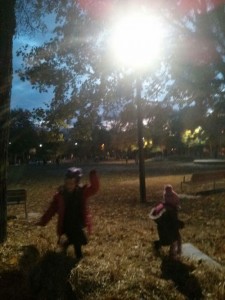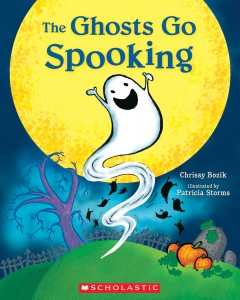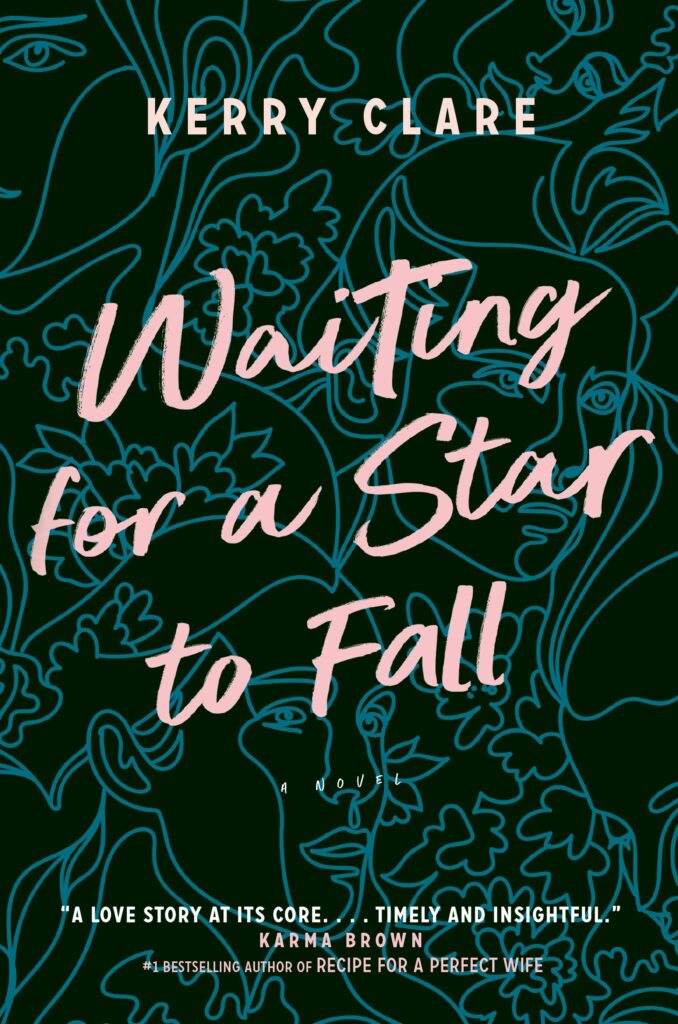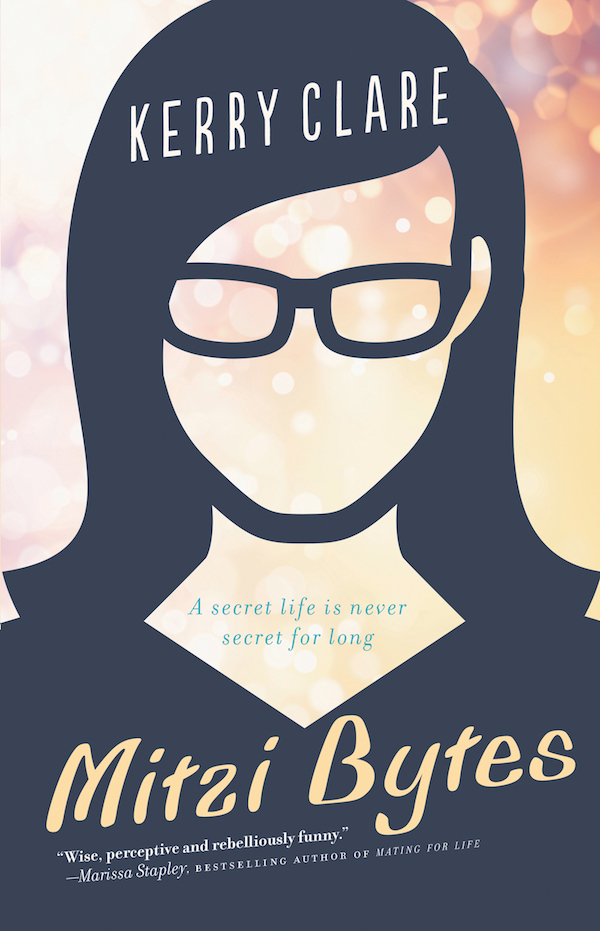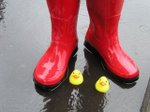November 8, 2015
Us, by David Nicholls
 “It’s like a Richard Curtis film,” will be the kind of description that sends half of you running, but (surprise, surprise) I’m in the other camp, and so I was all up for reading David Nicholls’ novel, Us. It’s the story of Douglas, a rather buttoned-up fellow whose wife Connie confesses late one night that after twenty-five years of marriage, perhaps she’s ready to leave him. Although it’s a tentative thing, her declaration, and they’ve already scheduled a summer trip across Europe with their teenage son that she’s determined to go through with. Leaving Douglas, who’s never too sure of himself in the first place, on particularly unsteady ground, and what ensues is continental hijinx and mayhem, bittersweetness and a bit of heartwarming.
“It’s like a Richard Curtis film,” will be the kind of description that sends half of you running, but (surprise, surprise) I’m in the other camp, and so I was all up for reading David Nicholls’ novel, Us. It’s the story of Douglas, a rather buttoned-up fellow whose wife Connie confesses late one night that after twenty-five years of marriage, perhaps she’s ready to leave him. Although it’s a tentative thing, her declaration, and they’ve already scheduled a summer trip across Europe with their teenage son that she’s determined to go through with. Leaving Douglas, who’s never too sure of himself in the first place, on particularly unsteady ground, and what ensues is continental hijinx and mayhem, bittersweetness and a bit of heartwarming.
The story weaves together the story of their trip with that of their relationship, starting with their first meeting at a dinner party, an unlikely connection between them. Connie is warm, passionate, artistic, while Douglas is an awkward biochemist, but each awakens something in the other, and Douglas finds himself in love for the first time in his life, moreover bowled over that Connie loves him too—he makes her laugh, he calms her storms, and their worlds are so different that each is fascinated with the other. Their relationship progresses, they move in together, buy a flat, and get married, which is straightforward enough, but life itself never is. There are bumps in the road, and there are tragedies, in particular the death of their daughter soon after her birth, an experience that tears them away from themselves, each other, and the entire world, before they’re able to reassemble to the pieces of the universe into something recognizable again, and even though they do, it’s something from which neither of them ever fully recover—Douglas in particular, who we know from his own evasions in the narrative lacks the emotional vocabulary to fully process what has happened to them. Though the experience also cements them like nothing else—no one else knew their baby, or loved her, and they resolve together to never forget her. Even the birth of their son not long after, while something like a balm, doesn’t take the pain away.
As their son grows, though, there becomes a new kind of pain. Life changes and Douglas leaves the job he loves in academia to better provide for his family, working long hours and commutating to a pharmaceutical company. And he begins to find himself displaced within their family home, that his wife and son are connected in a way that excludes him, and that his attempts to be the kind of father he wants to be—and even more, for his son to be the kid of boy he wants him to be—all fizzle, setting off a chain reaction of upset and disappointments. He loses his humour. His son has no respect for him, and doesn’t even like him, and no wonder. And then there is Connie, at four o’clock in the morning: “I think our marriage has run its course, Douglas, and I think I want to leave you.”
On their trip to Europe, Douglas becomes determined to prove to Connie that he is the man she fell in love and to their son that he is worthy of his love and respect. But things go very wrong before they’ve any chance of being right again. And it was some of these bits of the novel (which is 400 pages) at which my attention lagged. The addition of a sex-mad Australian accordion player to this cast was a good one, and the travel setting allowed Douglas to grate on his family’s nerves in a way that was particularly exacting. But it was the interactions between these characters that I loved best, and so Douglas wandering the streets of Amsterdam was always going to be less compelling, no matter who he meets on his wanderings.
Resolutions were also a bit pat as well, although I’d heard the Richard Curtis comparison, so what was I expecting. Curiously though, the novel is spattered with very literary epigrams: Penelope Fitzgerald, Lorrie Moore, Elizabeth Taylor (not that one), Henry James and Isaac Newton. Allusions as scattershot as Douglas’s attempts at harmony, or the travel itinerary that eventually transpired. Suggesting the novel comes with a certain literary heft, which is strange because its narrator isn’t at all the type. Surely this novel isn’t the type either. But then the references are also elsewhere woven into the text itself, and perhaps the project itself is to determine what kind of novel one can write about a man who doesn’t read novels. The inner life of a man who conducts himself as though he has no inner life, the stereotypical Englishman—perhaps a generation late. The kind of man who peruses his son’s social media accounts, and wonders with terror (at least I think it’s with terror): “Good God…how might I have fared in a world where people were free to say what they felt?” How far would the novel have to stretch to accommodate a narrator like that?
While the novel should have been shorter, I can determine that I liked it very much, most particularly for the complexity of its characters. Connie is just as flawed as Douglas is, and while initially they complement each other, it’s easy to see how the years roughen their edges and have them rub up together all wrong. She thwarts him just as much as he thwarts himself, and it’s all so terribly human and wrong. The novel is notable too for its portrayal of marriage—it reminded me of a line from Lorrie Moore’s Bark, that marriage “was like being snowbound with someone’s demented uncle.” But how does one get there? The path is never so straightforward. And David Nicholls has done a remarkable job of showing us the way.
November 6, 2015
Elephant Journey The True Story of Three Zoo Elephants and their Rescue from Captivity, by Rob Laidlaw and Brian Deines
Elephant Journey: The True Story of Three Zoo Elephants and their Rescue from Captivity, by Rob Laidlaw and Brian Deines, is a fantastic non-fiction book that uses the power of narrative (and the award-winning Deines’ gorgeous illustrations) to bring complex issues of animal protection to life. It’s the story of the two elephants from the Toronto Zoo who were brought there from African in the 1970s, when our understanding of the culture and purpose of zoos was very different, and one more who was born in captivity, all of whom failed to thrive in a northern climate so unsuited to their species. (For more about the zoo and elephants, read Nicholas Hune-Brown’s 2010 article, “What the Elephants Know”.)
After much political wrangling (which Laidlaw mercifully omits from his version of the tale), it was decided that the three elephants were to be moved to an animal sanctuary in California. And that amazing journey is the focus of this story, how the elephants were made accustomed to their crates, which where then picked up by giant cranes and loaded onto flatbed trailers towed by trucks. (And I love the illustration of the truck, being accompanied by a police car, headlights, streetlights, and flashing lights in the night; Deines is good at drawing trucks, one of which was a focus of Number 21, by Nancy Hundal, another book of his that we’ve enjoyed.)
The elephants make their way past surprised border guards, through the American midwest, and up and down the mountains in Utah and Nevada, where the brakes on one truck begin to overheat, but all is well after the driver douses them with water. And then the elephants arrive, become comfortable enough to leave their crates, and begin to acquaint themselves with their new neighbours, new surroundings and new lives.
Four pages of photographs, fact boxes and additional text add context and background to Laidlaw’s story, though the book stands well enough on its own without it. It’s a harrowing story with a most hopeful ending, and will make a definite impression on readers of all ages.
November 4, 2015
Butterflies
As much as I cherish the feeling of my children’s hands in mine, I do so love watching them race ahead of me down the sidewalk. I love their freedom, speed, their unfettered exuberance, the possibility that their feet might indeed sprout wings. Their sense of entitlement that this world, this city, is open to them. And I like trusting too that they’ll know to stop at the corner. Every time.
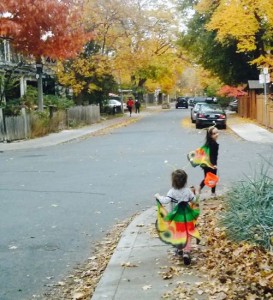 But there was something remarkable about watching them fly down the sidewalk on Saturday, Halloween, butterfly wings billowing out behind them, colourful spans. The most low-maintenence costumes in our family history of Halloweens—we had one pair of wings already, and borrowed the other from our cousin. We made antennae out of pipe-cleaners, styrofoam balls, and headbands. Ordinary clothes beneath. I was terrified that all this would backfire the night before and Harriet would decide that what she really wanted to be was a fiery glittery invisible incandescent humdingermabobber. Or Elsa. But she didn’t. And whatever Harriet wanted to be, Iris wanted to be too.
But there was something remarkable about watching them fly down the sidewalk on Saturday, Halloween, butterfly wings billowing out behind them, colourful spans. The most low-maintenence costumes in our family history of Halloweens—we had one pair of wings already, and borrowed the other from our cousin. We made antennae out of pipe-cleaners, styrofoam balls, and headbands. Ordinary clothes beneath. I was terrified that all this would backfire the night before and Harriet would decide that what she really wanted to be was a fiery glittery invisible incandescent humdingermabobber. Or Elsa. But she didn’t. And whatever Harriet wanted to be, Iris wanted to be too.
Butterflies are special to us. We can trace this back to ancient times, when Iris was a small baby and was given a dress with a butterfly print that was designed to become a shirt as baby grew. As Iris is small, it’s possible she’ll be wearing it forever. She loves it, and calls it her fuff-eye shirt, and now we all call butterflies fuff-eyes because this is what happens when you live with a two-year-old. And obviously, we like to read about them also.
We love love love Julie Worsted’s How To, which has a real butterfly or two, but also has a girl in fuff-eye wings on the “how to go fast” page. (From experience, I can say that wings are an excellent suggestion.)
Then there is Elly McKay’s Butterfly Park, about gardens and community, and mostly about McKay’s exquisite illustrations, which my children get lost in.
It’s also been a pleasure to revisit Up in the Garden and Down in the Dirt, a book we bought in July when gardening fever was at its height.
Autumn seemed a long way off then, so we’re re-reading it now with entirely new eyes—even if the butterflies are gone.
And butterflies always have been more than a little bit fleeting, haven’t they? Inherently ephemeral.
One of my favourite butterfly books is Bye Bye Butterflies, by our friend Andrew Larsen, which came out just before Harriet started preschool. And I’ve always linked the story to our own experience, in two ways. One, that this was a book about a kid going to school for the very first and beginning to make his way in the world—it was amazing to be on the cusp of that. And also that Charlie’s adventure caring for the butterflies was analogous to our own lives as parents. That these amazing, ever-changing creatures are only with us for a very short time before they find their wings and fly away—an achievement that makes us “a little happy and a little sad all at once.” Which is true.
But, yes, how joyful is watching them soar.
November 3, 2015
Rumi and the Red Handbag, by Shawna Lemay
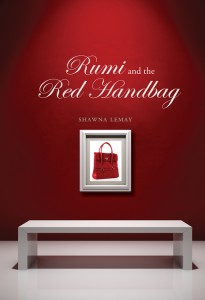 I am not a handbag person per se, but as a fervent believer in the secret (and sacred) lives of things, I’ve been really looking forward to Shawna Lemay’s novel, Rumi and the Red Handbag. And also as a fan of Lemay’s blog, Calm Things, and something that I found really wonderful about the book was how clear it was for those of us in the know that Lemay’s blogging is a huge part of her process. This is a book about handbags (among other things) by someone whose long-time blog was called “Capacious Hold-All,” after all, which is from Virginia Woolf’s diary, her description of what she wanted her diary to be. And so it seems that handbags are literary objects right from the novel’s departure—how could a reader ever have doubted?
I am not a handbag person per se, but as a fervent believer in the secret (and sacred) lives of things, I’ve been really looking forward to Shawna Lemay’s novel, Rumi and the Red Handbag. And also as a fan of Lemay’s blog, Calm Things, and something that I found really wonderful about the book was how clear it was for those of us in the know that Lemay’s blogging is a huge part of her process. This is a book about handbags (among other things) by someone whose long-time blog was called “Capacious Hold-All,” after all, which is from Virginia Woolf’s diary, her description of what she wanted her diary to be. And so it seems that handbags are literary objects right from the novel’s departure—how could a reader ever have doubted?
Rumi and the Red Handbag is a slim, heartbreaking and perfect read, rich with gorgeous prose, and depth and texture. Infused with allusions, explicit and otherwise, it’s a hushed and quiet celebration of women and their lives and their words and the secrets they carry. There is the Woolf, of course, and references to Clarice Lispector, who I’ve never read, but now I have to, and Charlotte Bronte, Jane Austen, Sylvia Plath. Plus vintage Harlequins—this is a book that permits great reverence to women’s stories and women’s spaces.
Our narrator is Shaya, on the run from academia and her unfinished thesis about the secrets of women writers. She takes a job at a consignment shop where she spends one long Edmonton winter in thrall to her young colleague, Ingrid-Simone, whose haphazard education consists of snippets and quotations and lines gleaned from library books that have a tendency to fall off the shelf right into her hands as she meanders her way through the stacks. She’s preoccupied by questions of the soul, by ideas in general. She floats around spouting lines in a manner that is one hand a bit simple and precious, but then she is young and it reminded me of the way my friends and I used to try to pin the down the world with bits and pieces once upon a time. I certainly remember that impulse, and Lemay captures it so well: “For Ingrid-Simone, the idea of hoarding thoughts, holding so many threads of ideas like cupped water as you knelt, knees grinding into finest gravel, thirsty by a mountain stream, did not terrify or oppress her instead exhilarated her.”
When things get a little too ethereal, Lemay balances it out by startling moments of revelation taking place under fluorescent lights at the Shoppers Drug Mart cosmetics counter, and also at Wal Mart. For while this is a novel concerned with questions of the soul, those questions are connected to the material world, in particular with the things that come and go from the shop where Shaya and Ingrid-Simone spend their days. Purses in particular are Ingrid-Simone’s things, and inspired by Shaya’s literary passions, she begins creating miniature purses inspired by writers and books: the first is a tiny capacious hold-all ala Virginia Woolf, authentic right down to a miniature pencil which inspires the writer’s walk in “Street Haunting.”
And so each woman inspires the other, and they learns from each other, and Ingrid-Simone reignites Shaya’s desire to start writing again, jotting words and ideas on post-it notes, “threads of ideas” (and there again we have connections to clothes and to textiles), like the way her friend thinks. Though all the pieces together still do not solve the inherent mystery of Ingrid-Simone—what secrets is she fleeing from? What is her connection to a curious red handbag? And there are other mysteries too—what about the goings-on of the shop’s proprietor, and also how can customers become so consumed by their own lives that they fail to acknowledge the humanity of service staff? A question that wears down on both Ingrid-Simone and Shaya as the long winter goes on.
With spring, however, comes revelations, and departures, and a journey that ends at the Museum of Bags and Purses in Amsterdam, a place Ingrid-Simone had long dreamed of making a pilgrimage to. A place that underlines her philosophy that there is a connection between a woman’s handbag and her soul. It’s a place for secrets, yes, and essential things, and for her stories. Especially for her stories.
For what is a handbag anyway but a place to keep a book?
November 1, 2015
The Future is Dark
“The future is dark, which is the best thing the future can be, I think…” —Virginia Woolf
Something has turned, not just the calendar, making the world around us distinctly November. The leaves on our big tree have gone suddenly from green to yellow, and are starting to fall. The clock has gone back, and the evening comes sooner. And yet the temperature is mild tonight. We walked up to the ice rink to meet our friends and go skating, and our hats and mitts were overkill. The sky was curiously mottled, dark clouds, setting sun and blue.
 We were looking forward to skating—our second time out this season. And our second time out skating as a foursome. Last weekend, we drove out to the west end and hooked Stuart up with his first pair of ice skates ever, and traded in Harriet’s last year pair for a bigger model. When Harriet and I first bought skates last Christmas, it seemed a dubious experiment—would we actually undermine our reputations as terrible Canadians and partake in a winter sport? But it turned out that we loved it, and Stuart looked on longingly. This year, Stuart is in on the fun, and Iris too on bob skates. Though we are particularly excited because we’ve been spent the last week tracking the postal progress of her brand new deluxe bob skates with straps that won’t fall off (we hope!) and they’re due to arrive any day now. And we’re even looking forward to skating proper on the outdoor rinks once they’re open because Stuart and I each bought a pair of snow pants, my first pair in many years. I actually think that they might change my life, and certainly will make walking the children to school at -40 degrees celsius much more bearable, not to mention outdoor play during playschool co-op shifts, and even the prospect of tobogganing. Last year we went tobogganing once, and my jeans got wet, and I was so cold, I could have cried.
We were looking forward to skating—our second time out this season. And our second time out skating as a foursome. Last weekend, we drove out to the west end and hooked Stuart up with his first pair of ice skates ever, and traded in Harriet’s last year pair for a bigger model. When Harriet and I first bought skates last Christmas, it seemed a dubious experiment—would we actually undermine our reputations as terrible Canadians and partake in a winter sport? But it turned out that we loved it, and Stuart looked on longingly. This year, Stuart is in on the fun, and Iris too on bob skates. Though we are particularly excited because we’ve been spent the last week tracking the postal progress of her brand new deluxe bob skates with straps that won’t fall off (we hope!) and they’re due to arrive any day now. And we’re even looking forward to skating proper on the outdoor rinks once they’re open because Stuart and I each bought a pair of snow pants, my first pair in many years. I actually think that they might change my life, and certainly will make walking the children to school at -40 degrees celsius much more bearable, not to mention outdoor play during playschool co-op shifts, and even the prospect of tobogganing. Last year we went tobogganing once, and my jeans got wet, and I was so cold, I could have cried.
 But all that was a long way off as we walked up Brunswick Avenue tonight, enjoying the strange light and the post-Halloween quiet. Stepping over smashed pumpkins, and being in the perfect place between warmth and chill. Arriving at the ice rink to find our friends there, everyone a bit disappointed. The Sunday night public skate schedule was from the summer, apparently. In autumn, the public skate is on Saturday. And it took me far too long to process that it wasn’t actually Saturday. Okay then. But it seemed that the entire park beside the rink was ablaze for some kind of festival, pumpkins lining its perimeter. Children were climbing ladders into up into trees and swinging from ropes in a manner that suggested that nobody had thought about safety permits or wavers. Someone else had set up straw-bales and an old mattress, and the children were taking turns flinging themselves upon it. The adjoining playground, whose climbing structure is a pirate ship, was absolutely full of children, taking in the festival, perhaps, as well as the perfect autumn night. (All this is so lovely—it has rained for the last three Halloweens, I think.)
But all that was a long way off as we walked up Brunswick Avenue tonight, enjoying the strange light and the post-Halloween quiet. Stepping over smashed pumpkins, and being in the perfect place between warmth and chill. Arriving at the ice rink to find our friends there, everyone a bit disappointed. The Sunday night public skate schedule was from the summer, apparently. In autumn, the public skate is on Saturday. And it took me far too long to process that it wasn’t actually Saturday. Okay then. But it seemed that the entire park beside the rink was ablaze for some kind of festival, pumpkins lining its perimeter. Children were climbing ladders into up into trees and swinging from ropes in a manner that suggested that nobody had thought about safety permits or wavers. Someone else had set up straw-bales and an old mattress, and the children were taking turns flinging themselves upon it. The adjoining playground, whose climbing structure is a pirate ship, was absolutely full of children, taking in the festival, perhaps, as well as the perfect autumn night. (All this is so lovely—it has rained for the last three Halloweens, I think.)
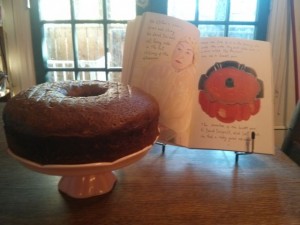 So we stood in the playground with our friends while our kids played, and it was perfect. And I was thinking about Rebecca Solnit’s essay, Woolf’s Darkness, which we’re reading tomorrow night in my blogging course. The line, which is also the epigraph to my novel, “To me, the grounds for hope are simply that we don’t know what will happen next…” I’ve been thinking about nighttime walks, and street haunting, and one thing leading to another. How exactly one year ago, when I was also about to be discussing Woolf’s Darkness with my blogging course (and yes, one might ask me the question: how have you managed to find a way to be paid for doing all the best things ever? To which I would reply: I have absolutely no idea…) and I wrote this post, one of my favourites ever: “On Uncertainty, Mistakes and Accidental Cake“, which might just be my philosophy of the world. Tonight another example: often, not ending up where you were intending to go turns out to be startlingly right.
So we stood in the playground with our friends while our kids played, and it was perfect. And I was thinking about Rebecca Solnit’s essay, Woolf’s Darkness, which we’re reading tomorrow night in my blogging course. The line, which is also the epigraph to my novel, “To me, the grounds for hope are simply that we don’t know what will happen next…” I’ve been thinking about nighttime walks, and street haunting, and one thing leading to another. How exactly one year ago, when I was also about to be discussing Woolf’s Darkness with my blogging course (and yes, one might ask me the question: how have you managed to find a way to be paid for doing all the best things ever? To which I would reply: I have absolutely no idea…) and I wrote this post, one of my favourites ever: “On Uncertainty, Mistakes and Accidental Cake“, which might just be my philosophy of the world. Tonight another example: often, not ending up where you were intending to go turns out to be startlingly right.
 We walked home again and it was dark outside. “I don’t like the dark,” said Harriet, who always claims that she can’t see at night, never mind the streetlights. I pointed out that what I liked best about walking in the dark was everybody’s lit windows, and how we could see the worlds inside. We decided to make a quick visit down to our own neighbourhood’s annual pumpkin festival before heading home for dinner: baked butternut squash risotto was waiting in a cast-iron pot on the stove. Although we were less excited about the pumpkin festival as we’d been in years previous, as our own pumpkin hadn’t been picked up to be part of it. We remain fuzzy on how which pumpkins get to be in the festival. I thought it was democratic, but ours keeps not getting picked up. Then we wondered if it was just that it sucked, but I don’t think that’s actually a barrier to entry. Anyway, just to demonstrate that we just didn’t care about any of this, okay, FINE!, we’d hacked our pumpkin to bits this afternoon with an intention to roasting it and making it into something to eat. As we walked home from the pumpkin festival, I was anticipating a rich pumpkin pudding—the perfect end to an excellent, albeit meandering evening.
We walked home again and it was dark outside. “I don’t like the dark,” said Harriet, who always claims that she can’t see at night, never mind the streetlights. I pointed out that what I liked best about walking in the dark was everybody’s lit windows, and how we could see the worlds inside. We decided to make a quick visit down to our own neighbourhood’s annual pumpkin festival before heading home for dinner: baked butternut squash risotto was waiting in a cast-iron pot on the stove. Although we were less excited about the pumpkin festival as we’d been in years previous, as our own pumpkin hadn’t been picked up to be part of it. We remain fuzzy on how which pumpkins get to be in the festival. I thought it was democratic, but ours keeps not getting picked up. Then we wondered if it was just that it sucked, but I don’t think that’s actually a barrier to entry. Anyway, just to demonstrate that we just didn’t care about any of this, okay, FINE!, we’d hacked our pumpkin to bits this afternoon with an intention to roasting it and making it into something to eat. As we walked home from the pumpkin festival, I was anticipating a rich pumpkin pudding—the perfect end to an excellent, albeit meandering evening.
 Oh, but reader, my pumpkin pudding was vile. Demonstrating that not all winding roads eventually lead to cake or such deliciousness. Sometimes one’s culinary accidents are scraped into the bin, and the problem isn’t solely that you forgot to add sugar (I know! What was I thinking?). But also that carving pumpkins are just fundamentally not meant to be eaten by creatures more discerning than raccoons. Which would be the point at which wiser women might give up, but oh no, that would be too easy. The grounds for hope are simply that we don’t know what will happen next, remember? So I’ve roasted the pumpkin, and now I’m going to turn it into soup. And if that doesn’t work, I’ll chuck the whole thing into the garbage and officially go to bed.
Oh, but reader, my pumpkin pudding was vile. Demonstrating that not all winding roads eventually lead to cake or such deliciousness. Sometimes one’s culinary accidents are scraped into the bin, and the problem isn’t solely that you forgot to add sugar (I know! What was I thinking?). But also that carving pumpkins are just fundamentally not meant to be eaten by creatures more discerning than raccoons. Which would be the point at which wiser women might give up, but oh no, that would be too easy. The grounds for hope are simply that we don’t know what will happen next, remember? So I’ve roasted the pumpkin, and now I’m going to turn it into soup. And if that doesn’t work, I’ll chuck the whole thing into the garbage and officially go to bed.
October 30, 2015
Missing Nimama, by Melanie Florence and François Thisdale
It’s not my usual practice here to write about a picture book that I haven’t read with my children, but Missing Nimama, by Melanie Florence and François Thisdale, is not your usual picture book. And I didn’t read it with my children not because they don’t know about Canada’s Missing and Murdered Indigenous Girls and Women—indeed, my 6 year old does know about this terrible part of our country’s colonial legacy, a legacy that’s lasted right up to this exact second—but because she told me she didn’t want to read a story that was sad. And neither did I, truthfully, to have to give voice to this story’s achingly, awful, beautiful words: the words of a mother who has been lost to her daughter but watches over her still, and the words of a daughter who has to grow up without the mother who loves her oh so much.
Stories of children who’ve lost their mothers are perhaps the most unbearable thing I can contemplate. So I don’t, usually. But in the case of Missing Nimama, I was compelled to read on, spurred on by Thisdale’s gorgeous dreamlike illustrations (which are similar in effect to his work in the acclaimed The Stamp Collector). I was also drawn by the story, written by Cree writer and journalist Florence. Her young character, Kateri, is raised by her loving maternal grandmother, who tells her that her mother is lost:
‘”If she’s lost, let’s just go and find her.”
Nohkom smooths my hair, soft and dark
as a raven’s wing.
Parts it. Braids it. Ties it with a red ribbon,
My mother’s favourite colour.
“She’s one of the lost women, kamamakos.”
She calls me “little butterfly.” Just like my nimama did.
Before she got lost.’
And then we hear nimama’s voice: “Taken. Taken from my home. Taken from my family. Taken from my daughter. My kamamakos. My beautiful little butterfly. I fought so hard to get back to you, Kateri. I wish I could tell you that. And when I couldn’t fight anymore, I closed my eyes. And saw your beautiful face.”

We see Kateri growing up, thriving under the loving care of her grandmother, and under the proud watchful eye of her mother. We see her grappling with her loss and grief, learning about her culture and traditions, growing up and finding her way in the world. And the heartbreaking sadness of the story is balanced by Kateri’s success in her life—the stability she finds as she grows older, gets married, has a child of her own. A stability that is against the odds, perhaps, and I think about Missing and Murdered Indigenous Women in connection with the history of Residential Schools and how many social problems in First Nations communities are results from over a century of cultural genocide. Not to mention the much more direct instances of government-sanctioned violence against Indigenous women in Canada.
I think of all these children who’ve lost their moms.
I don’t think that children like mine are necessarily who this picture book is meant for, not right at this moment in time, perhaps. For the far too many children for whom this story is close to home, however, I can’t imagine how powerful it would be to see one’s own experience reflected in a story like this, Kateri’s own story an inspiring example of the path a life can take, even one that begins with incalculable loss and trauma. (Which is not to say that this isn’t an important story for anyone—it’s such a visually compelling book that I’d like to keep it around, have my children leaf through, and become familiar with. We will definitely read it together. We’ll just have to ease our way into it…)
But then, someone might ask, why is it a picture book after all? Surely a book with such subject matter should be geared toward older readers? Should be a chapter book, at least? To which I respond that picture books have nothing to do with age. That grief and trauma don’t have a minimum age requirement either, sadly. That picture books allow this story to be accessible to all kinds of readers (and, remarkably, like all books from Clockwise Press, this one is printed in a “dyslexia-friendly” typeface). And most of all, that this story works because it’s a picture book, because of the marriage of words and stories, and how the respective voices of mother and daughter can exist together, even if apart, on the page.
Missing Nimama is a mourning song, but also a call to action. Near the end of the story, Kateri attends a public vigil for missing and murder aboriginal women: “Stolen sisters. I hold my own sign. My own lost loved one.” And the book’s final page contains quotations by family members of murdered women, from the UN Report which dictates that “Canada must take measures to establish a National Public Inquiry into cases of missing and murdered Aboriginal women and girls.” And our soon to be ex-Prime Minister’s infamous shameful view on the subject: “It isn’t really high on our radar, to be honest.”
The numbers are important, inarguable. “A total of 1181 Indigenous women and girls have been murdered or went missing between 1980 and 2012.”
But it’s going to be stories—like that this one—that make the difference if we’re to give all of our daughters a chance to live in a better world.
October 28, 2015
Another Margaret, by Janice MacDonald
 I really loved this piece about campus novels and academic mysteries that Janice MacDonald wrote for 49thShelf back in September—referencing Dorothy Sayers’ Gaudy Night, of course. So I’ve been looking forward to her latest novel, Another Margaret, her sixth book in the Randy Craig series set in Edmonton, Alberta. Which is also the first book in the series, a reworked version of an out-of-print 1993 book called The Next Margaret, MacDonald’s first to feature Miranda Craig, a hapless perennial academic with a penchant for sleuthing.
I really loved this piece about campus novels and academic mysteries that Janice MacDonald wrote for 49thShelf back in September—referencing Dorothy Sayers’ Gaudy Night, of course. So I’ve been looking forward to her latest novel, Another Margaret, her sixth book in the Randy Craig series set in Edmonton, Alberta. Which is also the first book in the series, a reworked version of an out-of-print 1993 book called The Next Margaret, MacDonald’s first to feature Miranda Craig, a hapless perennial academic with a penchant for sleuthing.
On the occasion of her 20th reunion—grad school at the University of Alberta, and her pal Denise has roped her into being part of the organizational committee—Randy’s mind drifts back to her MA studies and her fraught relationship with her thesis advisor. She’d gone back to school as a mature student to study up-and-coming but little known Canadian novelist Margaret Ahlers—yes, another Margaret, along with Laurence and Atwood—on whom her advisor, Dr. Hilary Quinn, had written critical works. But Dr. Quinn turns out to be oddly unforthcoming on the subject of Ahlers, and it is not long after announced that Ahlers herself has died. And whatever her connection to Dr. Quinn, it now seems complicated in a way that Randy is determined to get to the bottom of.
But the course of an academic detective story never did run smooth, and suddenly somebody else is dead—was it murder?—and Randy has got her fingers on a floppy disk that seems to contain a another novel by Ahlers. But the novel turns out to be a detective novel. A “brilliantly subversive detective novel,” but still: had Canada’s Great Literary Hope upped and gone genre? And if she was murdered, was that why?
“All that territory staked on the next Margaret Laurence, or Margaret Atwood, and she turns out to be the next Margaret Millar!”
MacDonald does a terrific job capturing the seasons of the academic year: the heightened expectations of autumn, and then come April, everybody is crying. The send-up of academia is fun and smart, and also important in what Randy’s work as a sessional instructor has to tell us about the precarious nature of academic work at the moment. I also enjoyed the novel’s glimpses into Canadian literary culture, including a funny bit when Randy starts a fake book blog to get an advanced copy of yet another new Ahlers novel that comes out right before the reunion—a novel that Randy knows could not have possibly been written by Ahlers herself.
 The prose style was clunky in places, and some of the leaps of logic (both taken by Randy and required by her reader) were a bit absurd, and then once there’s the stabbing with the plastic picnic knife—well? Well, that’s how you know that the whole project is done in the spirit of fun, not taking itself too seriously, but executed well enough that admirers of academic mysteries can come along for the ride. And I really glad I did. Another Margaret was a lot of fun, and a great introduction to the Randy Craig series. I’ve been been feeling unwell this week and the weather has been autumnal in the not-so-golden sense, and so this has been the perfect kind of story to curl up in.
The prose style was clunky in places, and some of the leaps of logic (both taken by Randy and required by her reader) were a bit absurd, and then once there’s the stabbing with the plastic picnic knife—well? Well, that’s how you know that the whole project is done in the spirit of fun, not taking itself too seriously, but executed well enough that admirers of academic mysteries can come along for the ride. And I really glad I did. Another Margaret was a lot of fun, and a great introduction to the Randy Craig series. I’ve been been feeling unwell this week and the weather has been autumnal in the not-so-golden sense, and so this has been the perfect kind of story to curl up in.
October 27, 2015
On Rereading: CNQ 93
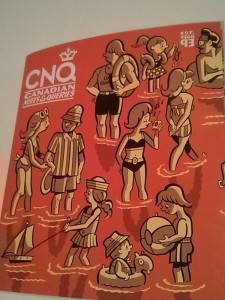 While I wish it were otherwise, the truth is that it’s rare for a magazine to arrive on my doorstep and for me to have devoured the entire thing in a day or two. But then a magazine like Canadian Notes & Queries 93 is a rare thing. Guest-edited by Kim Jernigan, beloved former long-time editor of The New Quarterly, the issue’s focus is on rereading, inspired by the 2005 anthology, Rereadings, edited by Anne Fadiman. And basically once Anne Fadiman turns up on page 7 of your magazine (in Jernigan’s intro: “On Rereading, its Pleasures and Perils”), I’m totally hooked.
While I wish it were otherwise, the truth is that it’s rare for a magazine to arrive on my doorstep and for me to have devoured the entire thing in a day or two. But then a magazine like Canadian Notes & Queries 93 is a rare thing. Guest-edited by Kim Jernigan, beloved former long-time editor of The New Quarterly, the issue’s focus is on rereading, inspired by the 2005 anthology, Rereadings, edited by Anne Fadiman. And basically once Anne Fadiman turns up on page 7 of your magazine (in Jernigan’s intro: “On Rereading, its Pleasures and Perils”), I’m totally hooked.
(I reference Fadiman in my own essay about rereading Fear of Flying; come to think of it, my most recently published essay is about rereading too. It seems that I am the target audience for this issue of CNQ.)
Do you know Anne Fadiman? Oh, but you have to. Her essay collections Ex Libris and At Large and At Small are two of the best books I have ever read. Loving Anne Fadiman’s work is a bit like being in the world’s best secret society, except none of it’s a secret and we want everyone to join.
Anyway, an entire magazine inspired by Anne Fadiman. Think of it. In fact, go out an buy it. To read Caroline Adderson on rereading (and rewriting) her first novel, A History of Forgetting. It’s about missteps, failure, cringeworthy moments, and on what remains: “First this book tortured me, now it’s humbled me.” And Carrie Snyder on reading The Prime of Miss Jean Brodie, which has changed and not changed both in what it has to tell her about being a writer: “It is the book I aspire to write…” And then Anne Marie Todkill on rereading Mrs. Dalloway. Kathy Friedman on Jane Urqhart’s Changing Heaven, which fails to measure up. (A funny aside: recently I spent an evening laughing hysterically with old friends about how strange we all were when we met nearly 20 years ago. One of us had a Jane Urquhart poster on the wall, my friend Kate remembers. This idea now seems absurd: that Urquhart had such cultural currency. I couldn’t believe it. And then not a half hour later, I was looking through an old scrapbook into which I’d etched a quotation from something by Urquhart, from The Whirlpool, maybe. I even now remember that I once wrote a poem inspired by her book, The Underpainter. All of this feels impossible now. Who knew she was such a touchstone?). And then Susan Olding on The Golden Notebook, weaving her read and her reread into a terrific story of learning lessons again and again, about fragmentation and discovery. The ways in which our readings and rereadings can go oh so wrong.
Plus there are three poems by Robyn Sarah, from her collection, My Shoes are Killing Me, which has been nominated for the Governor Generals Prize for Poetry. The kind of poems you read and that have to read aloud to whoever is sitting on the couch beside you. And a story, “Multicoloured Lights,” by Jess Taylor, from her short story collection, Pauls. And book reviews by Emily Donaldson and JC Sutcliffe. It really doesn’t get any better. (There is also work by men in the issue, although those are the ones that I skimmed…)
So go buy it. That’s all. I think it’s available on newsstands now, so go and delight in its goodness, in the worlds these pieces open and reopen, and how the best thing about literature is that we’re never ever though.
October 26, 2015
Good things to know
 Okay, I know it’s not even Halloween, but have you heard about the 2015 Short Story Advent Calendar? It’s better then chocolate (apparently?), 24 stories for readers to open every day leading up until Christmas. Contributors include Pasha Malla, Jess Walter, Heather O’Neill, Richard Van Camp, and Zsuzsi Gartner, and bunch of others whose identities are staying secret (but a few of whom emailed me on the down-low to let know they were involved, leading me to order my calendar. Trust me: you’re going to want to get in on this). Kudos to Michael Hingston and Natalie Olsen for taking the initiative and making it happen.
Okay, I know it’s not even Halloween, but have you heard about the 2015 Short Story Advent Calendar? It’s better then chocolate (apparently?), 24 stories for readers to open every day leading up until Christmas. Contributors include Pasha Malla, Jess Walter, Heather O’Neill, Richard Van Camp, and Zsuzsi Gartner, and bunch of others whose identities are staying secret (but a few of whom emailed me on the down-low to let know they were involved, leading me to order my calendar. Trust me: you’re going to want to get in on this). Kudos to Michael Hingston and Natalie Olsen for taking the initiative and making it happen.
And the reason we’re talking about it now is that the calendar is available as a one-time, limited edition print run. By which I mean: Get it while you can.
Oh, and another thing? Remember the panel I took part in at Quill & Quire about whether we’re living in a golden age of Canadian picture books? It’s now online and you can read our discussion here.
October 23, 2015
The Ghosts Go Spooking, by Chrissy Bozik and Patricia Storms
This week our family has been having fun with The Ghosts Go Spooking, a new picture book written by Chrissy Bozik and illustrated by my friend, Patricia Storms. Sung to the tune of The Ants Go Marching, the story traces the antics as a group of friendly ghosts make the most of Halloween night on their way to a costume party at a haunted house. A nice touch is that the ghosts themselves are costumed—as a clown, a witch, a cowboy. As as they go, one-by-one, two-by-two, etc., one of them (a different one every time—the scary one, the silly one, the wiggly one) stops and does a variety of things—knockings on a door, does a jive, does some tricks.
The story is more fun than scary, which is a good thing with our crowd, and my kids like the mischief the ghosts get up to, their amusing extra-textual dialogue in the illustrations: “Better than a rabbit,” exclaims the Bunny-hopping ghost when “the clever one” conjures bats from his hat. Momentum builds as the ghosts eventually end up spooking ten-by-ten, arriving at their party to find a horn-playing werewolf and a vampire on the double-bass, spooky rock-and-rolling against an enormous yellow moon. No doubt this is a party that will go one well into the night.
Boo boo boo…









